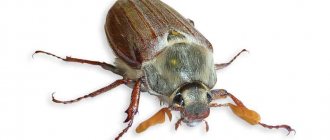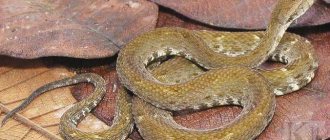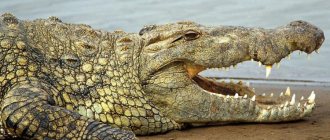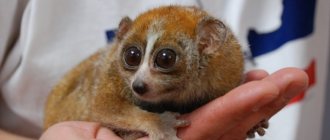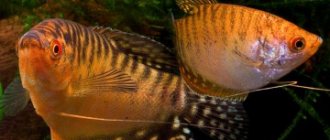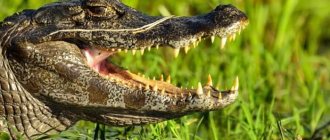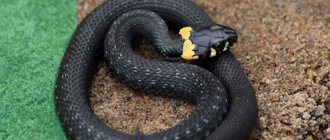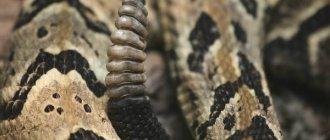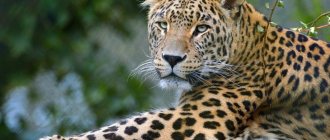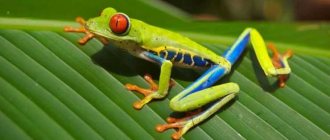Review author: “ZooVita”
Reptiles have long been in great demand among researchers. Various species of individuals are distributed on the territory of our planet in almost every corner of it. They differ from each other in length, color, and toxicity. Black species of snakes are considered the most dangerous.
Popular black reptiles
Experts identify several popular dark-colored individuals that many have probably seen. These include:
- Already;
- Viper;
- Black Mamba.
How is it different from other types of reptiles? This individual is distinguished by its speed and mobility. Most terrarium owners claim that these chordate species are harmless. Not really.
The reptile's eyeballs are round in shape. They actively move and are able to notice danger at a distance of 3 m. This shape provides them with the ability to quickly respond to the movement of prey.
The body color of snakes can vary. Some species have a light olive color, while others have a brownish-black tint. The family of snakes of this species includes many species. Each individual has its own characteristic differences.
Is the bite poisonous?
It is important to mention that just some time ago all poisonous snakes were called echidnas - in particular, even the black viper.
Look - Domestic turtles - the most popular species, cultivation features, tips for care and maintenance (115 photos + video)
However, the black snake is the leader in the amount of venom released during a bite, and its venom has a powerful toxic effect.
The substance enters the blood and provokes protein coagulation. Before attacking, the snake extends its head 15 cm, rises and attacks the victim in one sharp movement.
Despite the fact that in some cases, deaths have been recorded after a black echidna bite, the venom is not as toxic to humans as it is to animals. That is why cases of instant death are extremely rare.
Common types of snakes
There are three types of individuals that are common in the European part of Russia. These include:
Treatment in hospital
Hospitalization of the victim is mandatory. In a hospital, a viper bite is treated with specific, detoxification and symptomatic therapy. It is carried out in a traumatology, toxicology or intensive care unit.
Specific therapy
It consists of administering an antidote for a viper bite - an antisnake serum that has a neutralizing effect. Tetanus toxoid is also administered. The most effective early use of these drugs is within 4-6 hours after a viper bite.
Anti-snake serum contains antibodies (antitoxins) to snake venom. It serves as an antidote for viper bites. A serum is considered monovalent if its antibodies neutralize the venom of only one snake. This is a species-specific drug. When the venom of several species of snakes is neutralized, the serum is called polyvalent.
Detoxification therapy
To cleanse the body of poison after a viper bite, the following measures are taken:
- intravenous infusion;
- forced diuresis;
- oxygen inhalations.
If the victim has manifestations of acute renal and liver failure, then he undergoes hemodialysis and hemosorption.
Symptomatic therapy
Includes administration of the following viper bite remedies:
- glucocorticoid hormones - “Prednisolone”;
- antihistamines - “Suprastin”, “Pipolfen”, “Diphenhydramine”;
- cholinesterase inhibitors - “Proserin”;
- with accelerated blood clotting - anticoagulants;
- for bleeding - transfusion of fresh frozen plasma and platelet concentrate;
- in case of severe anemia - transfusion of red blood cells;
- painkillers;
- in case of secondary infection - antibiotics.
Treatment of local lesions
In the area of the viper bite the following is carried out:
- immobilization of the affected limb;
- cooling the bite site;
- application of an aseptic dressing and daily dressing of the wound;
- in case of severe swelling of the limb - fasciotomy (longitudinal incisions of the connective membrane covering the muscles);
- if foci of necrosis occur, necrectomy (removal of dead tissue) is performed.
Severe intoxications, accompanied by hypotension, coma, pulmonary edema and respiratory failure, require artificial ventilation, inotropic and vasopressor support.
Ordinary
Bright yellow spots on the sides of the head help to distinguish this individual from a dangerous viper. Outwardly, they have some resemblance to ears. The snake's body is a single color. Mostly dark gray or black shade.
There are no such differences in poisonous vipers. Her body has a reddish tint and a zigzag stripe from head to tail.
Notes
- Ananyeva N. B., Orlov N. L., Khalikov R. G., Darevsky I. S., Ryabov S. A., Barabanov A. V.
Atlas of reptiles of Northern Eurasia (taxonomic diversity, geographic distribution and conservation status). - St. Petersburg: Zoological Institute of the Russian Academy of Sciences, 2004. - 232 p. — 1000 copies. — ISBN 5-98092-007-2. - Bozhansky A. T.
[www.sevin.ru/redbooksevin/content/233.html NIKOLSKY’S VIPER - Vipera nikolskii Vedmederja, Grubant et Rudaeva, 1986] (Russian). Retrieved January 14, 2012. [www.webcitation.org/65VKw68s9 Archived from the original on February 17, 2012]. - [www.sevin.ru/vertebrates/index.html?Reptiles/79.html Vertebrates of Russia: Nikolsky's viper]
Water
This type of snake has a black spot on its head, resembling the Latin letter V. The sharp part of this element is located in the head part.
The body is painted in a dark olive shade with many brown spots located in a checkerboard pattern. The abdominal part is yellow and sometimes reddish.
Behavior
The reptile is active depending on the ambient temperature. In spring and autumn it is active during the day, and in summer it crawls out to hunt in the evening and hunts until the morning. In spring, it can be noticed when the temperature rises above 10°C. In the summer heat, it hides in shady and humid areas, and at temperatures around 30°C it tries to stay more in the water.
Depending on climatic conditions, hibernation begins from October to December and lasts until March or April. Already in September, snakes gather in one place to spend the winter together. Hibernation lasts from 4 to 6 months. Males awaken in the spring 2 weeks earlier than females.
Nikolsky's viper does not like windy weather; the greatest activity occurs after prolonged rains that replace drought.
At the slightest danger, she tries to hide under stones or in thick grass; she goes directly to the attack only for the purpose of self-defense, when there is no way to retreat.
Its natural enemies are birds of prey and mammals, in particular buzzards (Buteo buteo), lesser spotted eagles (Aquila pomarina), eagle owls (Bubo bubo), white storks (Ciconia ciconia), forest ferrets (Mustela putoris), badgers (Meles meles), European hedgehogs (Erinaceus europaeus) and wild pigs (Sus scrofa). Young snakes often become victims of water snakes (Natrix tessellata) and common snakes (Natrix natrix).
brindle
These representatives of the chordate family are distributed in the Far East, northern China and Japan. The first thing that catches your eye is their bright and quite variegated color.
The snake's back has a dark olive tint. There is a small black pattern along the entire perimeter of the body. There are bright brick-colored spots near the head. A black stripe is observed in the eye area. The snake has a wide collar on its neck.
Another distinctive feature of these individuals is the presence of a disgusting odor. In times of danger, they are protected by a stream of caustic liquid, which instantly scares away all predators.
Habitat
It is found in the territory from the Podolsk Upland on the western side to the Volga region, in the Saratov and Samara regions. Individuals settle in river valleys and along the outskirts of forests, in areas of fresh felling.
Favorite habitat is floodplain meadows, clearings in mixed forests, glades. From 2 to 5 individuals live on 1 hectare, in favorable zones - up to 15 individuals.
What do snakes eat?
A black snake with a yellow head is capable of obtaining food on land and in the depths of reservoirs. The diet of this individual contains different types of vertebrate organisms. Mainly:
- Small frogs;
- Various types of fish;
- Chicks;
- Tadpoles.
A hungry person can eat two frogs in one go. In the aquatic environment, it prefers to hunt tadpoles. Scientists say that snakes can hypnotize their future victims.
To maintain all vital processes, he must eat 3 times a week. A snake's diet may include a variety of animal products.
Diet
The described snake belongs to the group of predators, which means it feeds on live food: small animals and carrion. Its diet is dominated by mammals, but the viper also feeds on:
- mice;
- frogs;
- reptiles;
- small birds and chicks.
When kept in home terrariums, it can be fed with finely chopped pieces of meat.
Important! You cannot overfeed a snake: it will quickly become obese and will suffer from disruption of the functioning of its internal organs.
“
Underfeeding
”
is always better than
“
overfeeding
”
.
Main features of the viper
The black viper snake is considered one of the dangerous species of the chordate family. Individuals of this species have an elegant body shape. They are distributed throughout the Russian Federation and Ukraine. The habitat is located in forests and forested areas.
At birth, the snake has a dark brown tint. There is a bright zigzag stripe on the body. During the period of growing up, the characteristic feature gradually disappears and the body color becomes black.
The black viper is distinguished by its aggressiveness. She is capable of attacking humans and animals if they are considered a source of threat to her life. Upon contact, the snake delivers a fatal bite. Its poison is considered quite toxic to the human and animal body. Unlike an ordinary viper, its poisonous liquid is transparent.
The eyeballs have a bright yellow tint. The pupil is shaped like a diamond-shaped black stripe. The abdominal part is decorated with a pale yellow color. The photo of the black snake shows an adult.
The diet of this individual includes small rodents, large frogs, and small species of forest birds. Some snakes prefer to rob birds' nests. They actively eat eggs and small chicks.
However, these representatives of the chordate family themselves are a source of food for herons, storks, wolves, wild boars and cranes. Many people, when meeting such a snake, try to get rid of it.
At the moment of danger, she prefers to hide in the forest thicket, but if she fails to avoid danger, then the snake prefers to attack. It’s impossible to defend against her bite.
Lifestyle
The active period of the Nikolsky Viper begins in April and lasts until October. After wintering, which lasts 180 days, the males are the first to emerge from the shelters, after them the females awaken, only then it is the turn of the young. They lead a diurnal lifestyle.
The forest-steppe viper does not move quickly on the surface of the earth, but it swims well in water. Nikolsky's viper does not attack first and, when a person or predator approaches, prefers to crawl away. In case of danger, the snake wriggles, takes the form of an English S, emits a hiss and rushes at the threatening object. For humans, its bite is not fatal, although very painful.
To furnish her home, she chooses heaps of fallen leaves or brushwood, stone rubble, and small abandoned holes. Nikolsky's vipers spend the winter and emerge from hibernation in them. In such places the temperature rarely drops below + 2 Celsius.
The diet of adults consists of frogs, small fish, rodents, brittle spindle, and shrews. They mainly eat mice and voles. Snakes often destroy bird nests, eating their eggs and chicks. The young feed on spadefoot moths, small lizards and brown frogs.
Why is the black mamba dangerous?
This type of reptile is considered one of the most dangerous species of reptiles on earth. Scientists identify several significant factors for which she was awarded this title. These include:
- • Releases toxic poison that can kill a person in a few minutes;
- • The length of her body averages from 80 to 150 cm;
- • Has a quick response.
When danger approaches, a snake can move at a speed of 20 km/h. This individual is widespread in central Africa, Senegal, New Guinea and Ethiopia.
The habitat includes savannas, ravines and river valleys with a lot of dead wood, rocky and mountainous terrain. The snake uses dry vegetation for sunbathing and as a vantage point for hunting.
The reptile is active in the first half of the day. Most of the time she is in ambush. Upon contact, it releases a toxic liquid that can kill its victim in a few minutes. Digestion of food takes place on average within 24 hours.
Reproduction
The Nikolsky viper reaches puberty only at 4-5 years of age. The mating period begins in May, and the offspring appear towards the end of summer or in the first half of September (after about 90 days). The method of reproduction is false placental ovoviviparity.
During one pregnancy, 1 snake brings into this world up to 18 young individuals, the length of which, together with the tail, is 21 cm. The first molt of the young occurs 2-5 days after its birth, then new vipers become independent and begin to hunt.
What does the black mamba eat?
The diet of this snake consists of large birds in the form of eagles, mongooses and small reptiles. The black mamba prefers to exist alone.
During the breeding season, the male finds a partner based on a specific scent. Being close, he examines her body for the process of fertility. To do this, he uses his long tongue.
After sexual intercourse, the black mamba prefers to hide in rocky shelters. After a couple of months, she lays 20 eggs. After just 3 months, numerous offspring hatch. Most snakes die in the first week of their life.
The fact is that representatives of this species are considered excellent food for eagles, large rodents and other types of reptiles. Hot climate and lack of timely nutrition provokes the development of serious diseases, which can also cause their death.
Clinical manifestations
Most people immediately after contact feel pain and burning, but often those bitten do not feel anything, which is due to the effect of the poison on the nerve endings. Two wounds from the front teeth remain on the body, which clearly verifies the poisonousness of the snake.
Symptoms after a bite:
- wounds hardly bleed due to rapid blood clotting;
- in the first minutes, swelling and hyperemia develop in the affected area, they quickly increase;
- most often pain and severe burning are felt;
- a person experiences panic and fear of possible death;
- characterized by weakness, nausea, dizziness;
- a severe degree of damage is indicated by shortness of breath, swelling of the neck, severe redness or cyanosis of the face, fainting, and convulsions.
Negative symptoms develop within an hour, and after another couple of hours the patient’s condition may worsen somewhat. Then everything stabilizes. If there are no signs that threaten the life and health of the bitten person, then the introduction of an antidote will not be required.
Negative signs will completely disappear after 3-4 days. Nevertheless, no matter how healthy a person is, first aid is always required to reduce the negative consequences. Detailed instructions are given below.
Photos of black snakes
First aid for an injured child
- As with adults, the first thing to do is to make sure that there is no repeat bite.
- Then, you should reassure the child and, if necessary, his mother.
- Rinse the bite site and call an ambulance at the same time.
- It is advisable to place the child on the ground and ask him not to move.
- Before the ambulance arrives, you should suck out the poison from the wound (as written above).
- Be sure to give plenty of water to drink if tea is available.
- It is advisable to describe to the doctors the snake that bit the child so that they can guess whether it was a viper or not and prescribe the correct treatment.
